|
The Majestic
Lalique Mascots
By Tony Wraight
René Lalique was always experimenting-producing vases, statues, dinnerware
and so on-and in the late 1920s, he added car mascots to his production.
Twenty-nine mascot designs were created to grace the sleek cars of Hispano
Suiza, Isotta Fraschini, Bugatti, Bentley, etc. All were made from high quality
glass, and provision was made for them to be illuminated by special metal
mounts.
The popularity of the car mascots was such that Lalique commissioned
the Breves Gallery in Knightsbridge to supply them to British customers, and the
Breves name was placed on the side of the mounting. Priced from two pounds
twelve and sixpence (about $5) for a mounted Victoire or "Spirit of the Wind",
Breves had the world rights to market Lalique mascots.
Mascots of Particular
Note. The first Lalique mascot was commissioned by the Citroen company in 1925,
the "5 horses" for the model 5CV. There followed 27 more depicting horses'
heads, various bird and animal forms, nude figures and even a shooting star. The
mascots were made mostly in clear glass, satin finish, frosted finish, varying
degrees of tinting of amethyst and pink hues, and in a variety of colors
(purple, blue, amber, brown topaz, gray and also in opalescent glass, ranging
from deep blue to milky white opalescence). Sometimes, a yellow opalescence was
used with even a ruby topaz central core, which was used on the Small Cock
mascot. Sometimes, staining was added to enhance the line of the piece.
The
rarest production mascot is certainly the fox, with only a few known examples
surviving. The most famous and largest is the "Spirit of the Wind", which
epitomizes Art Deco styling and was used in the 1928 Paris Motor Salon, mounted
on a Minerva. At 10 inches in length, it would grace the bonnet of even the
largest limousine of the day.
A "one off" greyhound was made for His Royal
Highness Prince George of England, in about 1931 for his own personal use.
Some of the mascots were used more often as paperweights. The Small Cock is
actually far more suited for this purpose as the claws extend over the base,
thus making it very difficult to fit to the Breves mounts.
Three pieces were
produced in a flat disk and are very different from the rest of the range: the
St. Christopher, the patron saint of travelers and possibly the commonest piece;
the Archer; and the Greyhound.
René Lalique used much insight in producing
such a wide range to choose from. One can see that the Boar was obviously meant
for the hunting fraternity. The Fish for the fishermen, and so on, but some were
very odd choices, like the Frog. But again, the humorous and fertile mind of
René Lalique was used to continue to interest potential clients with very
unusual adornments to their cars.
Mounting & Illumination. All mascots
were mounted with Breves Gallery mounts of two basic sizes, and the full Breves
Gallery Knightsbridge address was always impressed on the outside of the
illuminated base types. Two different mounting rings were used, and virtually
all had a cut to accommodate mascots that were too big to allow a solid ring to
pass over the body. One has to pry the ring gently into position around the
base, then hopefully line up the ring thread to the base. It is very difficult
to do this without damaging the lip of the base, thus spoiling the piece
forever. Simple red rubber washers were provided for the mascot to sit snugly
onto the base, but over the years, these usually perished away and were
discarded.
The danger of damage is also great when finally tightening the
ring. While driving on the road, the slightest pressure on an over tightened or
slack mount would result in a serious base fracture. Add to this the problem
associated from heat generated from the inside illumination bulb, and one can
see why so few pieces actually have survived intact.
A 6- or 12- volt
festoon bulb was usually wired directly into a simple brass plug in the side of
the mount and then into the car wiring. The beauty of interior illumination was
further enhanced by an assortment of colored filters available at extra charge
in blue, red, green, mauve, white and amber. These were made of thick plastic,
but over the years, most warped and then were consumed by heat generated by the
bulb. For those wishing the ultimate in lighting spectacle, the Breves mount
could be fitted with a separate dynamo, sending various intensities of light
through the mascot as the car gathered speed-thus producing undoubtedly the most
spectacular adornment to a car bonnet that could ever have been devised.
Many of the mascots were very large and must have given the driver quite a
challenge in driving at night. In fact, I actually wired up a Victoire to the
front of a 1929 Bentley 8 litre and drove this car through central London at 3
a.m. on a Sunday night to try it out. The effect was truly awe inspiring, but it
was just as well there were few cars driving that memorable night.
Rarity.
The actual numbers produced are unknown, with no records existing at the present
day Lalique factory. Over the past decade, many have turned up at auctions or in
antique shops and are now eagerly sought after by glass and decorative art
collectors worldwide, plus car enthusiasts wishing to own a part of motoring
history. Sometimes, they turn up in an auction from deceased estates. But fewer
and fewer are showing up in auctions, as the new owners do not wish to discard
their treasured acquisitions.
The more costly pieces were those produced in
lesser numbers, including the Fox, Owl, Guinea Hen, Epsom, Comet, Peacock's Head
and Ram's Head. All others were bought in greater numbers with possibly the
Falcon, Boar, St. Christopher and the Small Cock being the most common.
Color and Tinting. Since very few were produced in color, the chance of
obtaining one is very minimal, and it is a quest that could go on for a
lifetime. Slightly easier to find are the tinted examples, though again few were
very strongly tinted. Not many were made in opalescent glass, though again here
the subject matter is the deciding factor in present day prices. When two pieces
sometimes found in opalescent glass differ greatly, i.e., the humble Fish and
the stylish Vitesse, then obviously the Vitesse is the greater prize, and the
value considerably higher.
Value. As they are so beautiful and rare compared
with today's mass production, these mascots are greatly sought after by
fastidious collectors who seek only perfect examples. This is now beginning to
force the rarer examples to higher levels. Three factors govern their value: the
rarity of the actual piece, the color or tinting factors, and of course, the
condition.
As the mascots were made specifically as car ornaments and not as
paperweights and were usually mounted on the radiator, many were damaged by
careless owners opening their bonnets without care and thus chipping the piece.
The Spirit of the Wind hair tip is especially vulnerable, and its value varies
greatly; the most minuscule chip will take many hundreds of pounds from its
value.
Many pieces have suffered damage in their lives, and many have been
ground by skillful hands over the years to hide the damage-it takes an
experienced eye to spot this. Sometimes pieces turn up for sale offered as
perfect by their owners, who are quite unaware of their imperfections; it is
wise to tread carefully when contemplating a purchase. In time, if you are lucky
enough to handle Lalique mascots, you will soon spot the vulnerable points.
Since any damage on a Lalique mascot represents a factor in the final price, it
is always advisable to remove a mount from a mascot to examine the base minutely
for defects.
Signatures. Most mascots are clearly marked on the base with
"R. LALIQUE", either molded or etched, or sometimes sandblasted onto the piece.
Some of the pieces have "LALIQUE" molded; the Small Dragonfly is one such
example. Post-war Lalique car mascots were also made by the Lalique factory, the
glass usually frosted, and "LALIQUE" sandblasted onto the bases; sometimes
"FRANCE" was also used.
As the Lalique factory still produces seven
paperweights today, which were originally made as car mascots (Chrysis, Eagle's
Head, Small Cock, Boar, Perch, St.
Christopher, and the Cock's Head),
inexperienced collectors are sometimes fooled by unscrupulous sellers into
parting with money on modern pieces worth between 70 and 150 pounds ($150-$277),
which are available from high quality glass retailers. They are, of course, all
marked clearly by the Crystal Lalique factory "LALIQUE FRANCE" in script lightly
etched on the base, and the glass is usually frosted and whiter than the pre-war
ones. Very easy to spot after handling pre-war examples, which have a grayer
effect.
Copies. As with all successful products, it was not long before
other rival firms decided to cash in on Lalique's success, sometimes blatantly
copying his designs. In the U.K., Red Ashay and Warren Kessler produced their
own designs, some being loosely based on Lalique pieces, the Red Ashay Vitesse
being an obvious example.
In France, the Sabino, Etling and Model companies
were also starting to produce glass mascots in small numbers, but they were all
inferior, and none matched the perfection of Lalique production techniques and
design genius. A Horse's Head, Spirit of the Wind and Eagles Head were marketed
in the thirties in the U.S. by the Persons Majestic Manufacturing Company of
Worcester, Mass., as a direct rival to Lalique.
These mascots were actually made
under license in Czechoslovakia, and some examples also carry the "Made in
Czechoslovakia" sandblasted signature. These are now collector's items in their
own right and are found in highly tinted yellow/green glass.
Fakes. Be aware
also today of a few modern Czechoslovakian design pieces. These are imported
into department stores worldwide and are loosely based copies of the original
Lalique designs. So far two types-Horses Heads and Spirit of the Wind-have
appeared, always mounted on black square resin bases and priced at around 50
pounds ($92) each. Of course, even here devious dealers have removed the glass
from its base, added spurious Lalique signatures, and tried to pass them off as
genuine. Luckily, the Spirit of the Wind's lower hairline curve differs totally
from the Lalique original, and of course, the finish is abysmal, cheaply mass
produced, badly molded, and finished in frosted modern glass.
During the
past few years, a few deep purple-colored pieces have appeared at auctions in
the U.K., U.S. and France. These apparently started life in Australia and
filtered into these markets. This odd color was produced by sending Cobalt 80
irradiation through authentic Lalique clear glass mascots, turning them an
extremely deep purple color. This was publicly exposed in London. Buyers should
be very wary when they are offered perfect purple mascots. I, myself, have
encountered examples produced using clear glass examples of the Cock's Head, Coq
Nain, Eagle's Head, Frog, Falcon, Small Dragonfly, Sirene and the Victoire.
Should you enter into the Lalique marketplace, proceed with caution, but
also with the knowledge that owning an original René Lalique car mascot, even
the humblest example, is a part of history and represents the style and grandeur
of motoring history never to be repeated.
Tony Wraight is
a collector and seller of Lalique and other mascots from the South Coast of
England, and the owner of Finesse Fine Art (www.finesse-fine-art.com). He can be
contacted at tony@finesse-fine-art.com or 07973886937.
10/2005
|
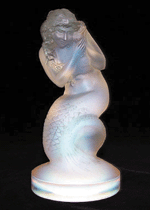
The Mermaid was actually a paperweight, too.
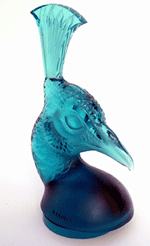
Peacock's
Head, extremely rare in turquoise.
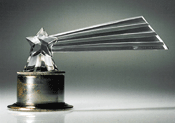
Comet,
none known to exist.
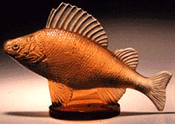
Perch, one of a few colored mascots.
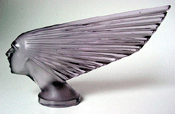
Victoire or Spirit of the Wind
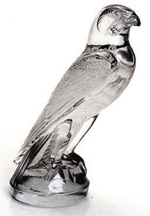
Falcon, usually clear,
beware of purple examples.
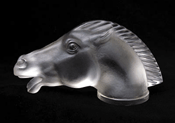
Epsom, Horse's Head
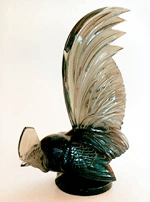
Cock, in clear, amethyst and smoked with ruby center.
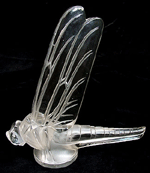
Examine the Dragonfly's fragile wings for breaks/chips.
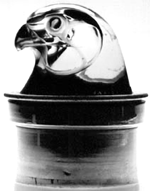
The regal Hawk's Head in clear, opalescent, smoked and amethyst. |